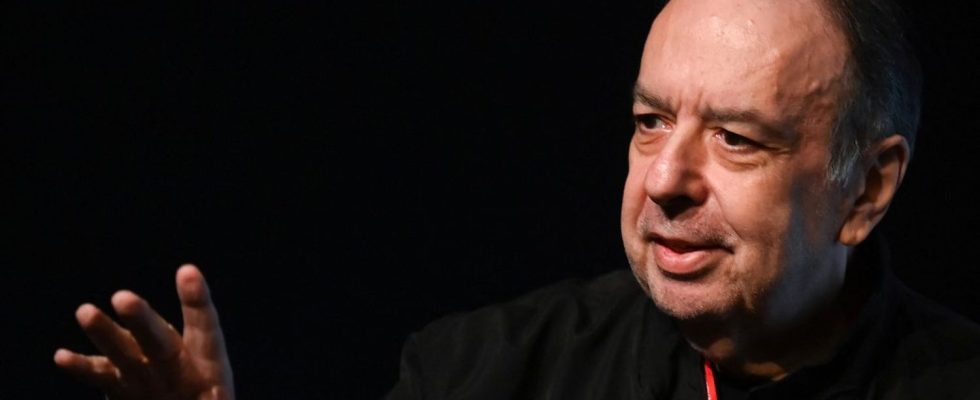This is one of the rare opportunities to discover, in around ten symphonic titles played live, from “Things of Life” to “La Guerre du feu”, one of the greatest French composers for cinema.
Published
Update
Reading time: 4 min

Composer for cinema since 1966, Philippe Sarde has signed some 250 scores for the image: a giant, performed under the direction of Mei-Ann Chen by the Orchester national de France at the Radio France Auditorium, Thursday April 4 at 8 p.m.
Identified with the films of Claude Sautet, for whom he wrote ten soundtracks, Philippe Sarde stands out for the trust he maintains with a number of other French directors. Jacques Doillon, Marco Ferreri, Pierre Granier-Deferre, Laurent Heynemann, Georges Lautner, Bertrand Tavernier and André Téchiné are loyal to him.
Final cut
Philippe Sarde was born in 1948 in Neuilly-sur-Seine, in an environment keen on culture: his father, Henri Sarde, was an antiques dealer and his mother, Andrée Gabriel, a mezzo-soprano at the Paris Opera. His brother Alain Sarde, for his part, became a film producer. The future musician’s godfather was Georges Auric, who in these post-war years was director of the Paris Opera. He introduced him to film music, being himself the signatory of numerous scores, including The beauty and the Beast by Jean Cocteau (1946) or The big mop by Gérard Oury (1966).
Unlike his compatriots Georges Delerue (Twins) or Maurice Jarre (Doctor Zhivago), who will have a good career in Hollywood, Philippe Sarde will not win America, preferring to have the “final cut” on his compositions, the “dream machine” tending to impose its choices rather than trusting the musicians. His approach is above all filmic, not musical, deduced from the inner feelings of the characters and emotions resulting from the action, and that the image cannot represent. Sarde thus defines himself as a “musical screenwriter”.
Instrumental identity
Also, the composition always starts from the instrument, which the musician identifies with the characters. It’s the double bass for the old crook of the Choice of weapons played by Yves Montant, where the glass organ identified with the Polish immigrant played by Roman Polanski in The tenant and who will commit suicide by throwing himself from his window onto a glass roof.
Considered an heir of film music composer Paul Misrak – who collaborated with Claude Chabrol, Henri-Georges Clouzot, Jean-Pierre Melville, Jean-Luc Godard, Luis Buñuel and Orson Welles – if jazz remains major among the influences of Philippe Sarde, so-called “learned” music is not left out.
We cite Claude Debussy in the lead, for the melodist’s “impressionist” sense and his nuanced string orchestrations. Arthur Honegger is also the most often cited. Signatory of ten symphonies and more intimate works, the composer also wrote for the screen, notably as Abel Gance’s official composer. The atonal side of Philippe Sarde takes its source from the contemporary creators of the genre: Igor Stravinsky, Béla Bartók and Krzysztof Penderecki.
Philippe Sarde, like Lalo Schifrin (Impossible mission), therefore has its roots in jazz, but he more readily cites Henry Mancini (The pink Panther) or Bernard Herrmann (Psychosis), with which it shares atonal colors.
“Things of life”
The Radio France concert playlist obviously covers Claude Sautet (The Things of Life, Nelly and Monsieur Arnaud, César and Rosalie), Alain Corneau (Fort Saganne, The Choice of Weapons), but also its sublime Tess (Roman Polansky), The fire war (Jean-Jacques Annaud) or the least expected, Feast (Marco Ferreri). A wonderful musical journey where film buffs will relive the images and where all music lovers will appreciate the dramatic research of a major composer.
In 1970, Philippe Sarde was 20 years old, Claude Sautet entrusted him with the music of Things of life, with Michel Piccoli and Romy Schneider. Listening to the theme on the piano, the director recognizes the musical atmosphere in A minor that he has in mind for his nostalgic film, a vision of a life passing by memorized, as death approaches. For this film, all in flashbacks, with the choppy unfolding of a car accident as a common thread, the young composer creates Helen’s Song. The lyrics do not appear in the film, but the radio will popularize the title, which remains a great moment of cinema song, performed by Romy and Piccoli.
Colorful orchestration
Immediately spotted by the filmmakers, after a second collaboration with Sautet on Max and the scrap dealers (1971), Philippe Sarde was approached by Pierre Granier-Deferre, Roger Vadim, Georges Lautner, José Giovanni, then all the next generation of the 1980s-1990s, with Alain Corneau, André Téchiné and Jacques Doillon. If Philippe Sarde knows how to set the intimate to music, he has a sense of the epic that we recognize in The War of Fire (1981), Fort Saganne (1983) or The Bear (1988).
The orchestra takes on a monumental scale in the number of musicians, but also in their instrumental palette. Jean-Jacques Annaud’s prehistoric film remains exemplary from this point of view in the orchestration with abysmal strings, punctuated by primitive percussion, enhanced by woodwinds and brass in an epic elevation of the choirs.
From this point of view, Philippe Sarde also has in common with Lalo Schifrin, the attraction for exotic instruments, which one does not spontaneously expect in the filmic register in which they are found. This may be Ron Carter’s omnipresent double bass in The Choice of Weapons or the swaying rumba which punctuates the tragicomedy of Wipe (Bertrand Tavernier, 1981). As such, the composer believes that he must “ensure that a jazz, rock, classical soloist or even a group become actors who will complete, definitively personify the film”.
Concert Philippe Sarde
Driver: Mei-Ann Chen
Thursday April 4, 2024, 8 p.m.
Radio France Auditorium
House of radio and music
116 avenue du Président-Kennedy, 75016 Paris
Tel: 01 56 40 15 16
